Question:
Aim: To show heat is transferred by conduction, convection and radiation.
Materials: Candle wax, water, matches, candle, incense stick, potassium permanganate crystal and thumbtacks
Apparatus: Copper rod, beaker, wire gauze, bell jar, bulb, T-shaped cardboard, thermometer, tripod stand, retort stand with clamp and Bunsen burner
(A) Conduction
1. Stick three thumbtacks on a copper rod using candle wax and set up the apparatus as shown in Figure 9.1.
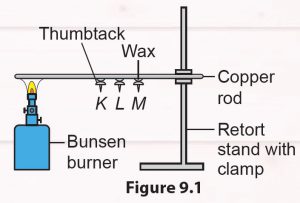
2. Heat the end of the copper rod and observe the sequence in which the thumbtacks fall off.
(B) Convection
(i) Convection in liquid
Safety Precaution
Make sure the potassium permanganate crystal sinks completely to the bottom of the beaker before it is heated up.
1. Fill a beaker with water and set up the apparatus as shown in Figure 9.2.
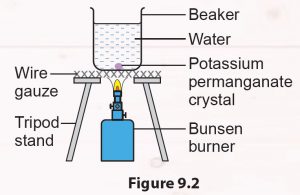
2. Heat the beaker slowly and observe the direction in which the potassium permanganate crystal moves inside the beaker.
(ii) Convection in gas
1. Light a candle and place it inside a beaker on one side and place the T-shaped cardboard in the middle of the beaker (Figure 9.3).
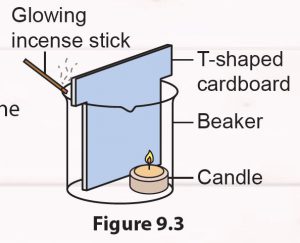
2. Bring a glowing incense stick close to the mouth of the beaker on the opposite side of the candle.
3. Observe the movement of smoke in the beaker.
(C) Radiation
1. Set up the apparatus as shown in Figure 9.4.
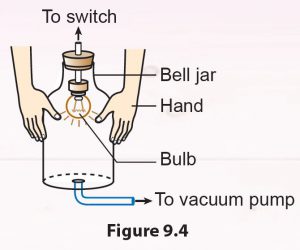
2. Fix the vacuum pump to the bell jar and remove the air from the jar.
3. Place your palms on the sides of the bell jar to feel the heat.
4. Switch on the bulb. After 10 minutes, place your palms on the sides of the bell jar to feel the heat.
Questions
1. Give an inference for your observation in Activity A.
2. Draw the direction of the convection current in liquid.
3. What is the use of the incense stick in Activity B?
4. State other ways to detect surface heat of the bell jar in Activity C.
Answer:
1. Thumbtack K on the copper rod falls off first because it is the closest to the heat source.
2.
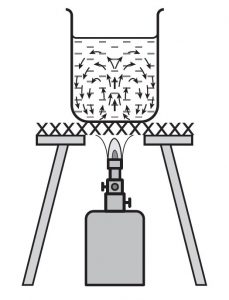
3. The convection current can be seen clearly.
4. Place a thermometer to the surface of the bell jar.
Aim: To show heat is transferred by conduction, convection and radiation.
Materials: Candle wax, water, matches, candle, incense stick, potassium permanganate crystal and thumbtacks
Apparatus: Copper rod, beaker, wire gauze, bell jar, bulb, T-shaped cardboard, thermometer, tripod stand, retort stand with clamp and Bunsen burner
(A) Conduction
1. Stick three thumbtacks on a copper rod using candle wax and set up the apparatus as shown in Figure 9.1.

2. Heat the end of the copper rod and observe the sequence in which the thumbtacks fall off.
(B) Convection
(i) Convection in liquid
Safety Precaution
Make sure the potassium permanganate crystal sinks completely to the bottom of the beaker before it is heated up.
1. Fill a beaker with water and set up the apparatus as shown in Figure 9.2.

2. Heat the beaker slowly and observe the direction in which the potassium permanganate crystal moves inside the beaker.
(ii) Convection in gas
1. Light a candle and place it inside a beaker on one side and place the T-shaped cardboard in the middle of the beaker (Figure 9.3).

2. Bring a glowing incense stick close to the mouth of the beaker on the opposite side of the candle.
3. Observe the movement of smoke in the beaker.
(C) Radiation
1. Set up the apparatus as shown in Figure 9.4.

2. Fix the vacuum pump to the bell jar and remove the air from the jar.
3. Place your palms on the sides of the bell jar to feel the heat.
4. Switch on the bulb. After 10 minutes, place your palms on the sides of the bell jar to feel the heat.
Questions
1. Give an inference for your observation in Activity A.
2. Draw the direction of the convection current in liquid.
3. What is the use of the incense stick in Activity B?
4. State other ways to detect surface heat of the bell jar in Activity C.
Answer:
1. Thumbtack K on the copper rod falls off first because it is the closest to the heat source.
2.

3. The convection current can be seen clearly.
4. Place a thermometer to the surface of the bell jar.